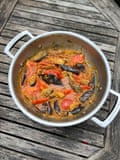
Bharta (also written as bhurta, vorta, bhorta and bartha, among other variations) is a happy family of spiced, crushed vegetable dishes particularly popular in northern India, Bangladesh and Pakistan.
Aloo ka bharta uses potato, shalgam ka bharta turnip, while today’s subject, baingan ka bharta, is an aubergine mash rendered smoky by flames. Mallika Basu calls it “the mother of all bhartas”, while Romy Gill says in her book Zaika that baingan ka bharta with dal and roti “would be my ultimate desert island dish”. Silky, tangy with tomato and onion, and with a deliciously burnt edge, it is, as Maunika Gowardhan notes, a deceptively simple recipe, and “home cooking at its best”.
The aubergines
Gowardhan reckons the secret of baingan ka bharta’s magic is “the way the aubergines are cooked. Charring them over an open flame means that a smoky, earthy flavour develops and lingers”. In her book Indian Kitchen: Secrets of Indian Home Cooking, she recommends blackening them over an open flame for best results, as do most people, with Saira Hamilton suggesting a barbecue as an alternative in My Bangladesh Kitchen, and Rick Stein a very hot overhead grill in his India book. Basu bakes her aubergines in a hot oven before charring them on a gas flame, which is less fiddly, but more energy-intensive, while Meera Sodha fries them and then smokes the finished result by popping in a hot charcoal with a little oil poured on top and leaving it to infuse for a couple of minutes.
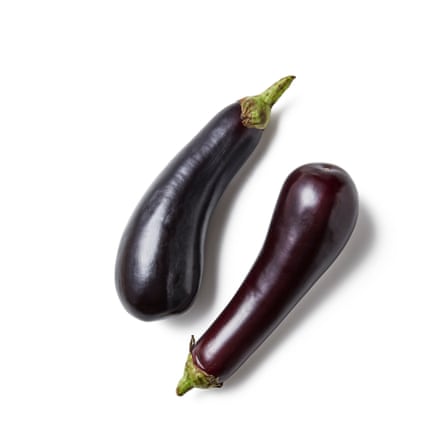
Every single one of them is enjoyable, but the most emphatically smoky results are from those done on a barbecue or over a gas flame. If you don’t have either of those things (or don’t fancy cleaning them afterwards), I’d recommend an overhead grill as the next best thing. If you don’t have one of those, then do as Meera does in Fresh India, though you will need to beg, borrow or steal a piece of charcoal first (please don’t steal it).
Chef Sanjeev Kapoor advises that “it is easier to remove the charred skin of a roasted eggplant if it is dipped in water just after roasting”, though Roopa Gulati recommends leaving on a few flecks of skin “for extra flavour”, a tip echoed by Harneet Baweja in the Gunpowder cookbook, and which, as a naturally slapdash cook, suits me fine. (Baweja also cautions against throwing the seedy core of the aubergine away. If this is something you do, you may wish to consider not doing it, though I’ve never heard of such a thing.)
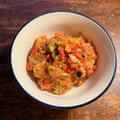
Whichever way you go about it, the aubergines need to be soft enough to mash with a fork or spoon, and, ideally, thoroughly blackened and blistered on the outside, so they look more like charred remains than something you’d like to eat. Smaller examples will cook through faster, so go for those if there’s a choice.
The supporting cast
Though aubergines get the big billing, chef Kapoor explains in his book How to Cook Indian: “this north Indian dish is as much about the sweetness of onions and the tanginess of tomatoes as it is about the smoky taste of roasted eggplant”. His version uses far more onion than the others I try – for each aubergine he uses five red onions (which approximate the sweetness of the Indian pink onion better than the harsher yellow variety)Far from overpowering the aubergine, they make a great contrast to its mellow bitterness, as well as to the more acidic taste of the tomatoes. (Sodha calls for white onions, which, again, are milder than the yellow variety, presumably for the same reason.)
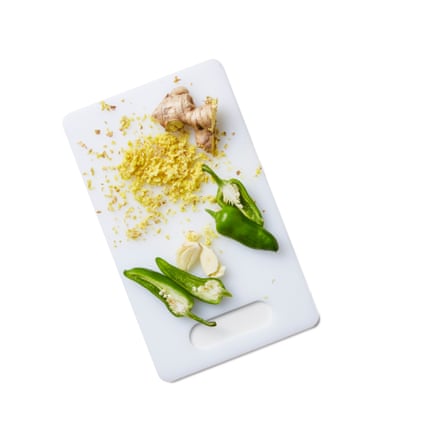
Use fresh tomatoes rather than tinned, if you can, because their sharpness is key – if yours are a bit disappointing, you may wish, like Gowardhan, to add a teaspoon of tomato puree: just enough to emphasise the fresh fruit, rather than turning it into a tomato sauce.
Kapoor’s bharta is very simple – just aubergines, onions, tomatoes, chilli powder and coriander leaves – showing you don’t need a lot of ingredients to achieve greatness here. That said, the widely used pairing of garlic and ginger adds to the depth of flavour, and I enjoy the more herbaceous warmth of the widely used green chillies to the dry fire of chilli powder.
Herbs and spices
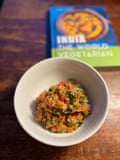
Cumin, ground coriander and turmeric are common additions in the recipes I try, but I’m sold on the garam masala used by Gulati in her book India: The World Vegetarian, a mix that tends to contain the first two along with the likes of cinnamon and cardamom to bring out the sweetness of the onions.
A final handful of chopped coriander, and a squeeze of Gulati and Hamilton’s lime juice for freshness, finishes things off nicely.
Any other business
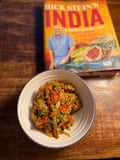
Ambica Aggarwal, whose recipe Stein includes in his book, cooks her bainghan ka bharta in mustard oil, which gives it a real kick, while Gulati and Baweja use ghee, whose richness I find irresistible. If you happen to have some, and eat dairy, the latter would be my preference, but neutral oil seems to be the more common and cheaper choice.
Serve, as Gill suggests, with roti and dal, or with Sodha’s rice or buttery naan and yoghurt, or with Gowardhan’s rice and dal, or as part of a thali. Or with baked potatoes, or baguette, or indeed anything you fancy, because this is a dish that can never be any less than delicious.
Perfect baingan bharta
Prep 10 min
Cook 40 min
Serves 4-6
2 medium aubergines (about 650g)
3 tbsp ghee, or neutral oil
3 red onions, peeled and sliced
Salt, to taste
20g root ginger, peeled and finely grated
2 garlic cloves, peeled and crushed
2 small green chillies, slit lengthways
½ tsp garam masala, plus extra to serve
4 medium tomatoes, roughly chopped
1 handful fresh coriander, to serve
1 lime, to serve
Lay the aubergines on the gas flame of the hob, or on a barbecue, and leave until very soft and black, turning regularly with heatproof tongs to ensure they cook evenly.
Alternatively, blacken under a hot grill. Either way, once blackened all over and soft within, leave until cool enough to handle.
Meanwhile, put the fat in a frying pan over a medium heat and saute the onions, stirring, with a pinch of salt until soft and limp.
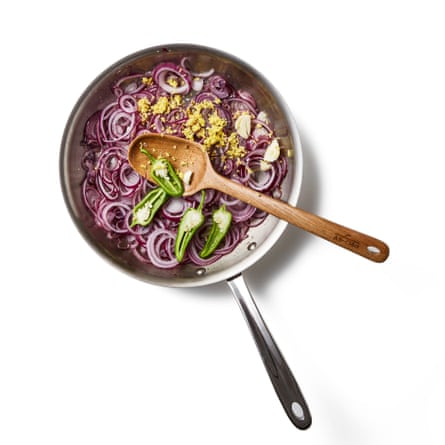
Stir in the ginger, garlic and chillies, cook, stirring, for another minute or so, then add the garam masala and tomatoes, and cook until the tomatoes start to soften.
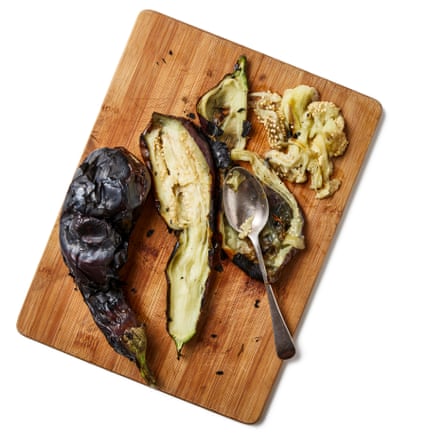
Scoop the aubergine flesh out of the skins (don’t worry if you get a bit of skin in there, too; it will only add to the flavour).
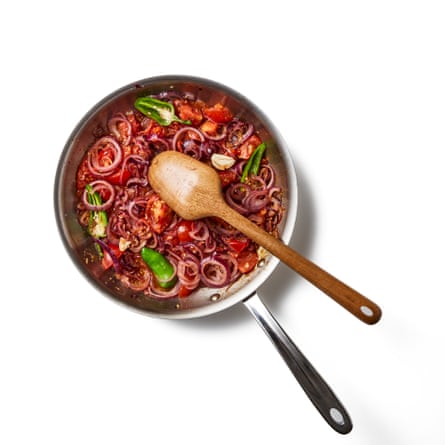
Add the aubergines to the pan. Mash with a wooden spoon or similar until fairly smooth, then leave to simmer until most of the liquid has evaporated.
Meanwhile, roughly chop the coriander.
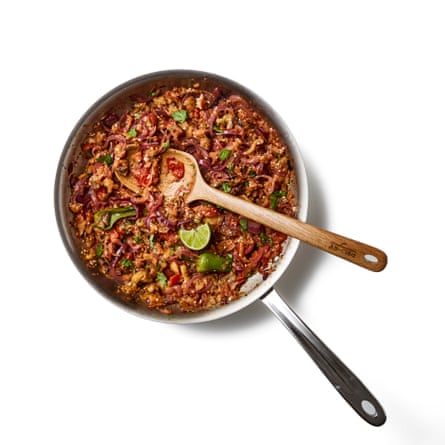
Stir through the chopped coriander and a little more garam masala to taste, squeeze in the lime juice, also to taste, then check the seasoning and adjust if necessary. Serve with rice or flatbreads.



